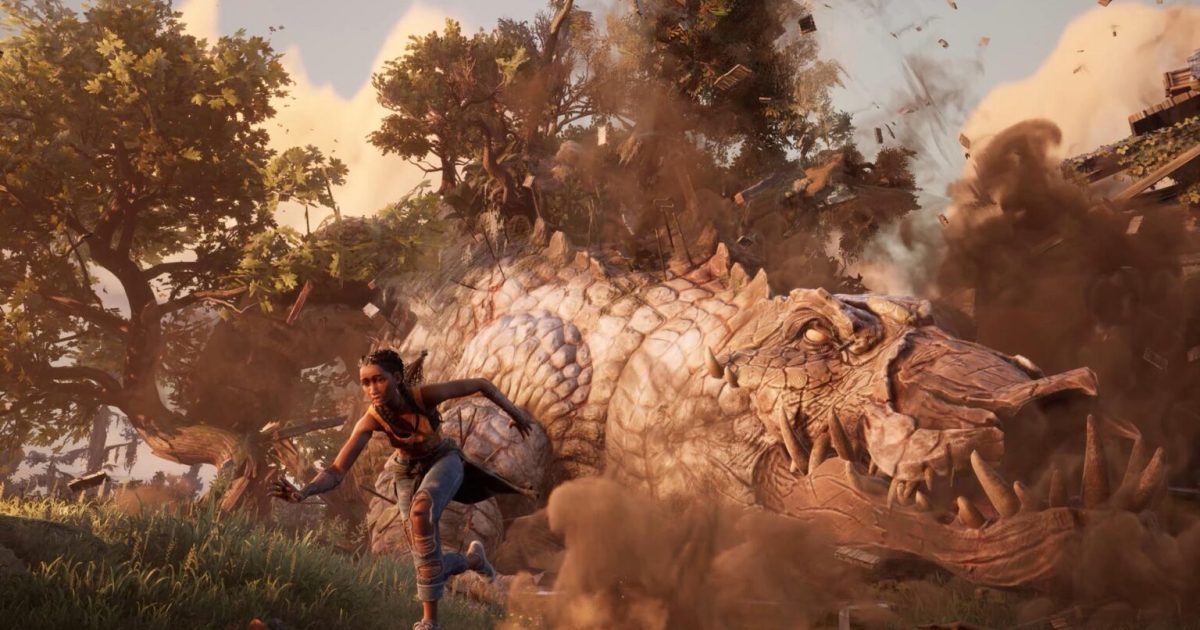South of Midnight
MSRP $40.00
“South of Midnight is a tremendous display of artistry, even if its gameplay doesn’t hit the same heights.”
Pros
- Heartfelt story
- Striking art direction
- Incredible music and sound
- A compact adventure
Cons
- The back half drags
- Repetitive structure
- Combat gets old fast
In the quiet town of Prospero, the Southern American setting of South of Midnight, the pains of the past leave a permanent mark. Trauma is not a scraped arm that fixes itself after a few days; it is a visible scar that can not heal on its own. It lives in the soil. It soaks into the trees through their roots. It thickens the swamp water and buzzes in the air alongside the mosquitos. If left untreated, it’s bound to get infected.
Developer Compulsion Games explores that idea in its latest action-adventure title, one that’s as invested in inventing a magical realist fantasy as it is diagnosing an illness in America’s real deep South. The specters of poverty and inequality lurk in the shadows like timeless folktale monsters. Prospero’s residents dare not say their names out loud; anyone who does ends up immortalized in a stray note left behind in an abandoned home. Rather than hiding from that darkness, South of Midnight recognizes that we can’t solve problems by ignoring them and assuming they’ll naturally resolve with time. We have to help our communities heal so the beauty within them can continue to blossom.
South of Midnight is a weighty adventure that pays tribute to the deep South with astonishing art, impeccable sound design, and the best music you’ll hear in a video game this year. It’s an emphatic journey about connecting with our most vulnerable neighbors when they need it most rather than leaving them to suffer alone. The artistic craft on display is unimpeachable, though the full package is weighed down by the demands of a big genre game that Compulsion isn’t fully able to keep up with.
There’s no place like Prospero
In an opening not so dissimilar to The Wizard of Oz, South of Midnight opens with a storm. Hazel, a teenage track star, and her mother are preparing to evacuate their small, rickety home when the two butt heads amid the tension. Next thing you know, the house is swept away into a raging river, separating the two women. After discovering that she has thread-controlling Weaver powers, Hazel sets out on a journey through Prospero to track down her mother (and their lost home) and reconcile with her before it’s too late. That sweet and simple mother-daughter tale makes up the story’s central artery, but blood pumps into its heart from multiple directions.
The narrative’s real draw is broader, as Compulsion uses its fictional town to explore the very real struggles of the deep South, particularly focused on the Black communities within it. Prospero is a quiet bayou town where history can be felt in its bones. The streets are lined with rundown houses that have been repossessed from families that are nowhere in sight. Scattered notes paint a damning picture of the exploitative factories on the outskirts of town that have worked Prospero’s residents to the bone for little pay and unsafe working conditions. Local eccentrics live on the edges of society like outcasts, all while holding in decades’ worth of personal tragedy.

It’s a magical realist setting filled with monsters inspired by Cajun folklore, but there’s a sobering reality under all the fantastical layers. This isn’t so far off from real towns in the American South where residents have been left to fend for themselves by a government that is keen to pretend that the injustices of the past are ancient history. It’s a primarily Black community where you can still feel the long-term effects of racial injustice. The story rarely calls explicit attention to those historical undertones, but you can feel how hard generations have worked to rebuild Prospero into a safe haven with no resources.
Hazel’s story is as much about reconnecting with her mother as it is learning to be a part of that community. The game’s 14 chapters take her to different parts of town where she encounters local legends tied up in tragedy. Exploitation, death, and kidnapping still haunt the people of Prospero, often manifesting as folk creatures like the Rougarou. Hazel isn’t just tasked with slaying monsters, including an army of Haints that have sprouted up around town; her job is to listen to those who have been left to suffer in silence. Each chapter is about giving empathy to those who desperately need it and using Hazel’s Weaver powers to bandage wounds that have been left to fester.
Those tales, these places, this history — it all deserves a spot on center stage.
A standout example of that comes early on as Hazel must help out a giant catfish that has found itself ensnared in the branches of an enormous tree. What starts out as a standard video game mission full of platforming soon reveals itself to be the tragic tale of Benjy, a child whose brother left him to die in the trunk of a tree. It’s South of Midnight’s central metaphor: the unresolved pain of a community has been baked into bark that towers over the town. It’s not just the people of Prospero who need help healing, but the land itself.
The voice cast works hard to sell those feelings, fully committing to the setting. Adriyan Rae in particular owns her role as Hazel, putting forth spunk and compassion in equal measure. You feel like she’s someone who really cares about her town and wants to take care of her own, even if she’s still a teenage wiseass at heart.
South of Midnight’s story does start to unravel around its halfway point. Hazel’s relationship with her mother takes too much of a backseat around that point, as the adventure seems more invested in paying visual homage to New Orleans and other pockets of the region. It all wraps up a little abruptly considering how emotionally charged the first half is. It’s a moment where I’m left to question whether or not the project is a bit too much of a sightseeing adventure for Compulsion, a studio based out of Canada. There’s enough sensitivity here, though, to dispel that worry. The studio creates a fictional town here that feels rooted in authenticity. It’s the kind of story that big budget video games have rarely, if ever, dared to tell. Those tales, these places, this history — it all deserves a spot on center stage.
Sights and sounds
Though South of Midnight’s story is rooted in deep-seeded trauma, Compulsion’s aim isn’t to take pity on the South. Instead, it seeks to celebrate the rich culture and history of the region. That comes through in art, music, sound, and lots of references to great art of the area. All of the literary references that should have been in Split Fiction are here instead, with homages to Flannery O’Connor, Zora Neale Hurston, William Faulkner and more. The story itself plays out like a tribute to Daniel Wallace’s Big Fish, fusing Southern gothic with the kind of magical realism that’s well-suited for a larger-than-life video game adventure.

You can feel the genuine admiration for the South from the breadth of film and literary references, and that same care is baked into every step of the creative process. The most striking example of that is South of Midnight’s art style, which pulls its inspiration from stop-motion animation (while still maintaining a smooth framerate on top of an “animating on twos” effect). It’s not just a flashy gimmick; it’s what the story calls for. Compulsion tells a human tale here where you can feel the imprint of history’s thumb in every corner of the world. There’s no better way to capture that than by referencing a medium defined by its hand-crafted element. These aren’t robotic assets copied and pasted throughout the world. Everything, from Hazel’s face to quilts draped over banisters, feels like it was made by hand. The effect doesn’t quite go as far as Harold Halibut, a 14-year project painstakingly made through photogrammetry, but Compulsion does an impressive job of mimicking the medium in 3D.
There’s a level of detail here that I’ve rarely seen games like it achieve. Every single corner of Prospero feels like a distinct space. Houses aren’t just copied and pasted buildings reused in each chapter. Each one has an entirely different layout, cluttered with items and memories that tell a story. A ratty mattress shoved under a staircase tells me exactly how one family was living. Other spaces I visit have walls covered in crosses or family photos. I can feel the people who have been left behind everywhere I go. They are always with me.
While that art is sure to turn heads, sound is South of Midnight’s secret weapon. That starts with its phenomenal original score, which fuses rustic folk music, big band jazz, and gospel to create a video game soundtrack unlike any I’ve heard at this scale. It’s an ever-changing ode to the music of the South that fluidly bounces between lonely banjo twanging and the kind of exuberant orchestral showtunes that you’d expect out of a 90s Disney movie.
By keeping things slim, Compulsion is able to put more care into everything it touches …
What’s more impressive is the quiet moments. Usually when I stand still in a video game, there’s not too much to hear. Maybe I’ll catch a bit of environment noise and a bird or two, but it tends to be just enough background noise to create a sense of space. South of Midnight, on the other hand, understands that nature is an orchestra. When I stand still here, I can hear a thick pack of mosquitos buzzing through the air, birds squawking in the distance, a frog croaking at my feet. When I close my eyes, I can feel the environment. The swamp air fills my lungs. The heat of the bayou sun touches down on my skin. I can see the golden yellow light illuminating the dead grass. Video games simply don’t sound like this, and I don’t know if I’ll ever be able to hear something like Assassin’s Creed Shadows the same way again after this.
I’d wager that a lot of these strengths come from South of Midnight’s compact scope. It is not trying to be an enormous, open-ended adventure with tons of space to explore. While that always sounds more freeing for players, it tends to be restrictive for the artists who need to fill the canvas. The bigger the game, the less hand-crafted it tends to feel. Assets are reused, music repeats, cost-saving tricks are implemented. By keeping things slim, Compulsion is able to put more care into everything it touches so that it can bring the South to life in a way that feels thoughtful and authentic.
A so-so adventure
The artistry of it all is remarkable, but Compulsion runs into conflict when trying to balance its artistic ambitions with what’s expected of an action-adventure video game of this scale. This is the largest project the studio has ever produced and I can feel that inexperience rear its head here and there. That isn’t to say that South of Midnight isn’t a perfectly fine action-adventure game. It is, even if it’s not striving to be mechanically inventive. It’s more that Compulsion struggles to string some good ideas through a full 12 hour story.
Gameplay plays out as a traditional third-person adventure game. Hazel can double jump and air dash from platform to platform, occasionally clamoring up painted cliffs like Nathan Drake. It’s a straightforward, linear adventure formula — and it’s fitting for the story. South of Midnight is meant to feel like a timeless folktale. It makes sense for it to play out like a foundational adventure game, something that feels canonical. While playing, I was brought back to genre classics like Beyond Good and Evil that were able to fully transport me to another place without leaning too heavily on the concept of “immersion” to create bloated worlds. This is similarly laser-focused, like a tale sprung out of a storybook’s pages.
I found myself wishing that Compulsion had taken everything here and compressed it into one heck of animated film instead.
It’s just the execution that doesn’t fully bring that vision together. What initially feels refreshing becomes formulaic by the second half. Chapters have me collecting memories in bottles, fighting through repetitive arena fights with Haints, and running through an occasional platforming gauntlet where I inevitably need to wall run and skirt around thorny plants. As soon as I could identify the pattern, the otherwise natural world began to feel too mechanical for its subject matter.
Combat is the primary issue. Every battle drops Hazel into a round arena where a few different kinds of Haints spawn in. She can hit her enemies with basic slashes, but also use her Weaver powers to bind enemies, mind control them with her trusty doll companion, push them away, or drag them closer. I found a great flow in the early chapters as I learned how to use my powers to create distance between enemies, carefully timing my finishing maneuver to unravel a foe and get a bit of health. There’s a little bit of Kena: Bridge of Spirits, Hogwarts Legacy, and even Doom in here, which gives combat encounters a great sense of (literal) push and pull.
There aren’t enough tricks here to sustain the amount of fights that feel needlessly crammed in here, though. I had learned just about every trick I could in the first third, with only a few extra skills to unlock that mostly buffed the effectiveness of my skills. It feels perfectly satisfying to yank Hazel towards an enemy, bind it in thread, hit it with a few slashes, and repel it into a wall to get some separation, but that loop never really changes, even as it introduces beefier Haints that just require more slashing to defeat. The only reprieve comes in a handful of exhilarating boss fights, like a clash with Two-Toed Tom, a giant gator who gnashes at me with its jaws as I try to stun it with the ring of a church bell.

The more the second half dragged, the more I wished that South of Midnight wasn’t constrained by its action-adventure game needs. It is doing so much to set itself apart from its peers in its sound, art, and narrative, but so much of its gameplay feels obligatory. There has to be combat, and lots of it, to fulfill the “action” half of the genre. My Weaver powers have to be used to collect hundreds of Floofs from the same few environmental puzzles that get me to walk off the beaten path and extend the runtime. Even at a brisk 12 hours, the adventure feels longer than it is as it drags me through the motions. Sometimes, I found myself wishing that Compulsion had taken everything here and compressed it into one heck of animated film instead.
I’m glad that it didn’t, though. South of Midnight is daring for something of its scale, putting its faith in players’ desire for video games that reflect reality rather than shy away from it. As fantastical as it all is, this is a story meant to pull us closer to the very real struggles that people in forgotten pockets of America face. It wants players to confront wealth inequality rather than use it as toothless set dressing. It wants us to consider how Black communities are often left behind. It wants us to accept that America’s dark history is not a distant memory, but a disease that will continue to mutate until we take meaningful steps to make amends. It is a healing process that requires human hands.
Just as a stop motion figure can not walk without someone there to articulate its limbs, our world stops moving the moment we decide that it doesn’t need us to support it anymore.
South of Midnight was tested on Xbox Series X.
Read the full article here














